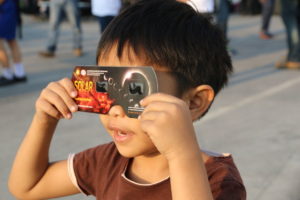First glimpse of #SolarEclipse2017 totality in Oregon! Take a look here and watch our live stream for more: https://t.co/cOKssim1bY pic.twitter.com/g9zEbWFXfk
— NASA (@NASA) August 21, 2017
People near the area of totality of the Great American Eclipse were treated to an amazing sight on Monday, as the sky was engulfed in total darkness.
Although watching it from a distance was nice, the National Aeronautics and Space Administration (NASA) still had the best seats in the house and recently shared its captured images of the astronomical phenomenon.
Tons of photos from the eclipse were shared on social media recently, but NASA’s GOES-16 satellite captured several breathtaking images from space.
The gorgeous imagery was streamed by NASA live, using its specialized telescopes, the International Space Station, planes and high-altitude balloons.
Station transits sun at 5 miles per second in video taken at 1,500 frames per second with high-speed camera from Banner, Wyoming. pic.twitter.com/x6NNvCc0Af
— Intl. Space Station (@Space_Station) August 21, 2017
Some of NASA’s esteemed astronauts also shared their photos during the rare aerial spectacle.
Voila! The #Eclipse2017 shadow from @Space_Station, no words needed // Voilà! L’eclisse vista dalla Stazione Spaziale, non servono parole… pic.twitter.com/7kD5AYb5zj
— Paolo Nespoli (@astro_paolo) August 21, 2017
Astronauts aboard the @Space_Station captured this amazing image of the Moon’s shadow over the U.S. during #SolarEclipse2017. pic.twitter.com/YrhTwpF1OC
— NASA Ames (@NASAAmes) August 21, 2017
Meanwhile, the US will not experience another solar eclipse until 2024, which makes the stunning images much more special. /ra
RELATED STORIES:
‘My eyes hurt’ queries flooded Google after solar eclipse
LOOK: International Space Station photobombs August 21 solar eclipse
